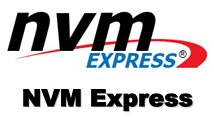- Joined
- Oct 9, 2007
- Messages
- 47,612 (7.45/day)
- Location
- Dublin, Ireland
| System Name | RBMK-1000 |
|---|---|
| Processor | AMD Ryzen 7 5700G |
| Motherboard | Gigabyte B550 AORUS Elite V2 |
| Cooling | DeepCool Gammax L240 V2 |
| Memory | 2x 16GB DDR4-3200 |
| Video Card(s) | Galax RTX 4070 Ti EX |
| Storage | Samsung 990 1TB |
| Display(s) | BenQ 1440p 60 Hz 27-inch |
| Case | Corsair Carbide 100R |
| Audio Device(s) | ASUS SupremeFX S1220A |
| Power Supply | Cooler Master MWE Gold 650W |
| Mouse | ASUS ROG Strix Impact |
| Keyboard | Gamdias Hermes E2 |
| Software | Windows 11 Pro |
NVM Express, the special interest group behind the NVMe protocol, which enables significantly higher performance on flash-based storage devices, compared to the AHCI protocol, published the NVMe 1.3 specification. This is the most significant update to the protocol since the NVMe 1.2 specification released in 2014. NVMe 1.3, which could be implemented in SSDs, motherboards, and HBA cards starting late-2017 or 2018, introduces several major features that increase performance, endurance, and manageability of flash-based storage devices, such as SSDs.
To begin with, NVMe 1.3 introduces a drive self-test feature similar to SMART. The host machine can now command the drive to perform a self-test without having to mount volumes and expose their contents to OS-based utilities. The self-test parameters could be left up to the drive vendor, and could include hardware tests in addition to data integrity tests. The protocol also adds much needed support for boot-partitions, without needing the motherboard UEFI firmware to store it. The current implementation of motherboards with NVMe booting support involves storing a tiny boot partition with the bootloader on the SPI flash chip of the motherboard which stores the UEFI firmware.

Also included in the NVMe 1.3 protocol is the new "sanitize" command, which performs a hardware-level secure-erase, which wipes data from not just the NAND flash user-area, but also the controller memory buffer, overprovisioning area, DRAM cache, etc., ensuring a more reliable data wipe. The specification also adds Single Root I/O Virtualization (SRIO-V) support.
View at TechPowerUp Main Site
To begin with, NVMe 1.3 introduces a drive self-test feature similar to SMART. The host machine can now command the drive to perform a self-test without having to mount volumes and expose their contents to OS-based utilities. The self-test parameters could be left up to the drive vendor, and could include hardware tests in addition to data integrity tests. The protocol also adds much needed support for boot-partitions, without needing the motherboard UEFI firmware to store it. The current implementation of motherboards with NVMe booting support involves storing a tiny boot partition with the bootloader on the SPI flash chip of the motherboard which stores the UEFI firmware.

Also included in the NVMe 1.3 protocol is the new "sanitize" command, which performs a hardware-level secure-erase, which wipes data from not just the NAND flash user-area, but also the controller memory buffer, overprovisioning area, DRAM cache, etc., ensuring a more reliable data wipe. The specification also adds Single Root I/O Virtualization (SRIO-V) support.
View at TechPowerUp Main Site




